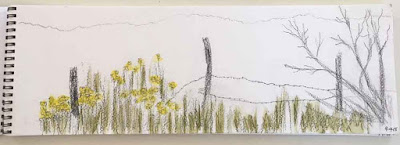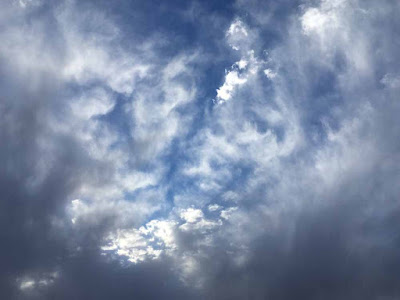Sunday before last I had the opportunity to hear a panel of accomplished artists from three different New Mexico pueblos speak about their work and about the history and current situation of Pueblo textiles. It was eye-opening for me. The discussion was sponsored by the
School for Advanced Research and held at the
New Mexico Museum of Art. The moderator of the discussion was
Brian Vallo (Acoma), Director of the Indian Arts Research Center at the School for Advanced Research. Artist panelists were
Isabel Gonzalez (Jemez),
Aric Chopito (Zuni), and
Louie Garcia (Tiwa).
As I listened to the panelists, I discovered that I am almost wholly ignorant of Pueblo textile traditions. Like many fiber artists, I am acquainted with Navajo and Rio Grande weaving and Spanish colcha embroidery. Living in New Mexico I am blessed with the frequent opportunity to see examples of these traditional art forms. But weaving and embroidery by members of the 19 pueblos? Not so much. I learned from the panelists that these traditions have nearly died out, and while there is some resurgence of interest in teaching and learning traditional skills and practices, their survival is by no means certain.
One problem that many of us fiber artists understand it is that it is very hard to survive on one’s income from weaving or embroidery. The process is so time-consuming that the products are out of reach for many. Another issue is that non-native weavers are producing Pueblo-type textiles and selling them to Pueblo people for much less than native artists using traditional methods and practices can do.
This brings me to my second big realization. My attitude about appropriation shifted 180 degrees as a result of this panel discussion. I confess: I had previously thought that cultures have always borrowed from one another, and they always will. It thought it is pointless to insist on the purity of an artistic tradition and futile to try to preserve it in some kind of bubble from outside contamination. The history of art, music, literature and craft are replete with examples of cross-pollination between cultures. But as I listened to these artists speak about how intimately intertwined their processes are with sacred prayers, stories, rituals, and family and community history, I realized that in the American context, “borrowing” by non-Natives is at best naive, uninformed opportunism and at worst a cynical ripping off.
Context is everything. Given the facts of American history, non-Native artists simply have no right to attempt to reproduce Native textiles in their forms, patterns, and techniques. They are not ours to use.
Besides, if non-Native appropriation of Native work offends Natives, that is in itself a sufficiently powerful reason not to do it. Human values of empathy, understanding and reconciliation outweigh artistic concerns. Besides, as an Anglo of mostly European descent, I have plenty of material and technique from my own artistic lineage to explore and use.
I recognize that I am rather late in coming to this realization. The debate about appropriation has been raging for quite awhile. Recently,
Rebecca Mezoff and
Michiele Elliott have written movingly of their own experience with these issues.
The third big realization I had was related to the second. Each artist spoke repeatedly about how their work and each part of the process was informed by communal history and sacred beliefs. We modern artists tend to see our work as individual self-expression, or perhaps a response to contemporary issues and life, but rarely as part of a larger sacred purpose. Our mission for over 100 years has been to innovate, our mantra has been to “make it new,” while for these artists, the preservation of traditional techniques for the good of the wider community is paramount.
Isabel teared up when she described how her painstakingly embroidered pieces are used in sacred ceremonies. Aric shared his attempt, with his son, to make a rabbit skin blanket like those that were made by members of his community over a century ago, an example of which he found in a museum collection. The laborious process was accompanied throughout by the saying of prayers for the good of the community. When the blanket was complete, Aric and his son heard the patter of rain on the roof . . . as if heaven itself, in this arid country, had seen and blessed their efforts. Louie spoke of how he is teaching weaving to Pueblo people, but acknowledged that only a tiny percentage of his students have the gifts and resources necesssary to continue weaving.
How many of us (and I include myself in this question) look up from our work to consider its role in our larger community—beyond commerce? Those of us who teach may be contributing to the greater good (I hope and believe this is true) but we probably don’t see it as part of a communal sacred trust. How can the practice of our art forms help to repair the world?
I am far from having the answers to these questions, but I am grateful for the chance to consider them in a new light. I look forward to finding out more about Pueblo textiles. If you are in the Albuquerque area, you might plan to check out this event Louie shared:






















































